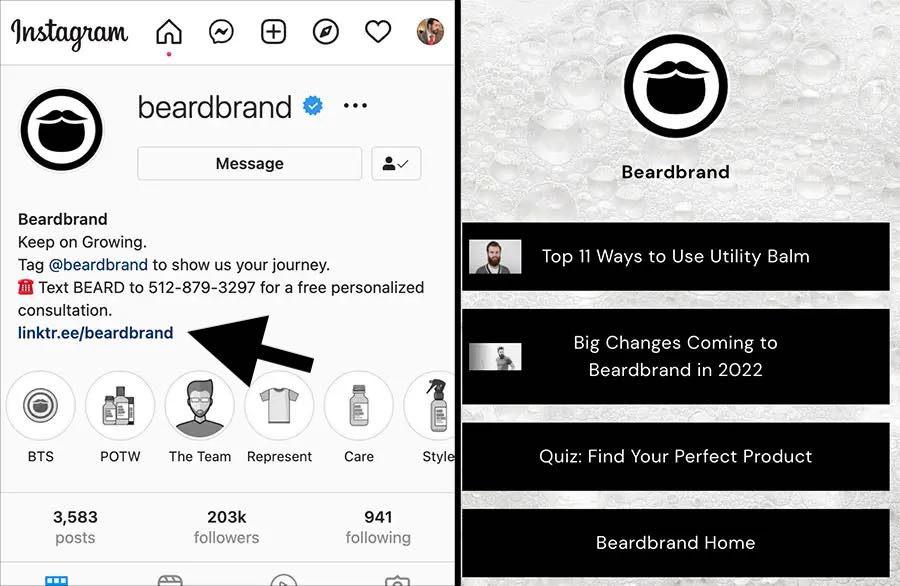Landing pages from links in social media bios can grow an audience, sell products, and promote content via social media. What’s more, setting up the page can be easy.
Instagram limits links in post descriptions. The limitations have led to the practice of adding the “link in bio” phrase to posts. The idea is that when someone wants to learn more about a post, that person can click a link in the company’s or creator’s bio.
Link Pages
The link-in-bio approach had a couple of challenges.
First, updating the link for each new post is a maintenance problem. Social media managers typically use tools such as Hootsuite, Buffer, and Later to schedule posts. But adding bio links is manual and cannot be scheduled.
Second, someone might want to learn more about an old post and click the link in the bio only to find that it had been replaced.
The solution to both problems is a link page, a mobile-friendly list of links associated with recent posts.

On the left is a screen capture of the Beardbrand Instagram page, including a bio link. On the right is Beardbrand’s link page.
In some cases, updates to the link page can be scheduled — like the post itself — using a content management solution or social media scheduling software.
Grow an Audience
One of the challenges of social media marketing is growing an audience. Creators — musicians, artists, podcasters, coaches — and businesses need a way to “own” their audience.
This requires engagement beyond social media followers. Link pages can help.
Consider Arnold Schwarzenegger. His link-in-bio landing page featured an email newsletter subscription form.

Arnold Schwarzenegger’s Instagram account includes a bio link to a landing page with a newsletter subscription form.
Schwarzenegger uses his Instagram account with more than 22 million followers to drive newsletter subscriptions. For a creator or a company, an email list is far more valuable than an army of social media fans. With engaged email subscribers, a business can promote products and drive revenue.
James Clear, author of the book “Atomic Habits,” also uses his Instagram bio link for newsletter subscriptions.

Author James Clear promotes his newsletter via a bio link. Clear’s email newsletter has been an important driver of his success.
Sell Products
Social media bio or profile links can also sell products. A few link-in-bio tools, including Buffer’s Shop Grid, can link from the bio directly to an ecommerce product page, for example.
The product link page might include incentives to click, such as free shipping or a gift with purchase.
Mejuri, an online jeweler, links from its Instagram bio to an Instagram collection page on Mejuri’s site, featuring many of the same rings, necklaces, and earrings in the company’s posts.

Mejuri’s link page is an ecommerce collection featuring products that have recently appeared in the company’s Instagram posts.
Promote Content
Link pages can also elevate content marketing.
For example, BigCommerce recently posted on Instagram about its partnership with Tottenham Hotspur F.C. in the U.K.
BigCommerce also included a Tottenham Hotspur link on its link page to a press release.
Ultimately, BigCommerce is driving traffic to its website and, in this case, a press release describing how the English Premier League football club is using BigCommerce to “modernize” its online store.
Any business could follow a similar pattern, promoting articles, videos, or podcast episodes.
Build a Link Page
There are at least four ways to build a link page.
- Bio link tool. There are more than a dozen tools as of February 2022 for link-in-bio landing pages. They require no coding or development. Some offer a free version. Providers include the pioneering Linktree as well as Feedlink, Lnk.Bio, Link in Profile, and Campsite.
- Existing website. Any content management platform — WordPress, Squarespace, Shopify, many more — can publish a link page formatted like Linktree or a mobile landing page. The page would exist on the business’s own website.
- Social scheduler. Later, Buffer, and several other social scheduling tools offer some form of a link page. The services also provide post scheduling, making it easy to coordinate post and link content.
- Marketing platform. Any marketing platform capable of producing a landing page can also have a link page. The benefit comes from integrating newsletter- and SMS-subscription signup forms or similar to capture a lead for a marketing automation flow.







